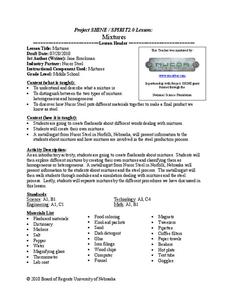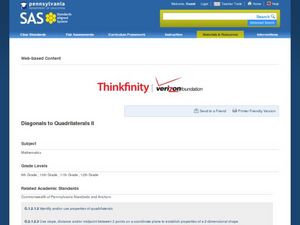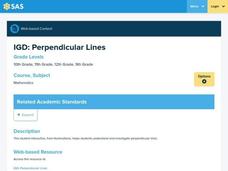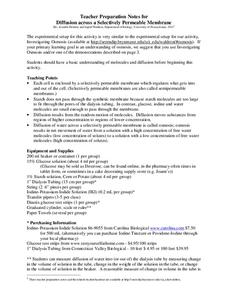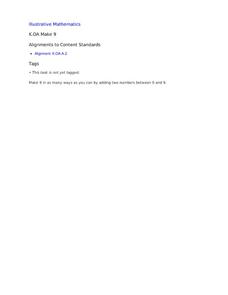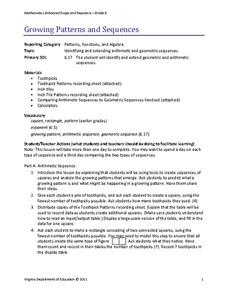Curated OER
Physical or Chemical- That Is the Question!
Young scholars differentiate physical and chemical changes. In this chemistry instructional activity, students give examples of each type of change. They take the review quiz at the end of the instructional activity.
Curated OER
How are we Related?
Students differentiate functions based on their domain and range. In this algebra lesson, students define function, domain, range and relation. They analyze graphs and coordinate pairs for input and output values making up a function.
Curated OER
Mixtures
Students differentiate the two types of mixtures. In this chemistry instructional activity, students create their own mixture and classify them according to their type. They simulate steel production with the help of a guest speaker.
Curated OER
Using a Multi- Sensory Approach
Students identify the slope of a line given two points on the line. In this algebra lesson, students solve linear equations by finding and comparing slopes of lines. They differentiate between the steepness of the slope and the line.
Curated OER
Connecting Translations, Reflections, and Rotations
Learners differentiate between translation, reflection and rotation. They explore the 3 types of transformation using Cabri Jr. and build on previous knowledge in this lesson plan.
Curated OER
Simson Line
Stuednts identify triangles for the Simson Line. In this geometry lesson, students solve triangular problems using the properties of triangles.They differentiate between the height, congruency and similarity.
Curated OER
Classifying Transformations
Pupils analyze different polygons by shapes and sides. For this geometry lesson, students differentiate between similar and congruent polygons. They name the different polygons based on the number of sides.
Curated OER
Diagonals to Quadrilaterals II
Students identify the properties of different polygons. In this geometry instructional activity, students find the slope of a line and calculate the distance between two lines. They differentiate between similar and congruent polygons.
Curated OER
Perpendicular Lines
Students differentiate between parallel and perpendicular lines. For this geometry lesson, students identify the different angles created by perpendicular lines and parallel lines. They name the angles that are form when parallel lines...
Curated OER
Mirror Tool
Students define properties of polygons. In this geometry lesson, students differentiate between similar and congruent polygons. They identify and use the properties of solids to solve problems.
Curated OER
Menelaus' Theorem
Students investigate Menelaus Theorem. In this geometry lesson, students calculate the area of polygons. They differentiate between boundaries point, interior points and area of lattice points.
Curated OER
Exploring the Slopes of Parallel and Perpendicular Lines
Students calculate the slope of parallel and perpendicular lines.In this algebra lesson plan, students differentiate between parallel and perpendicular lines. They graph their lines using the slope of the equation.
Curated OER
Exploring the Slopes of Parallel and Perpendicular Lines.
Pupils find the slopes for perpendicular and parallel lines. In this geometry lesson, students differentiate between parallel and perpendicular lines. They use Cabri software to create lines to compare.
Curated OER
Diffusion Across a Selectively Permeable Membrane
Learners investigate how water passes through cell membranes. In this biology lesson, students differentiate osmosis and diffusion. They illustrate the movement of water in both processes.
Illustrative Mathematics
Make 9
Learning how numbers are put together as parts and wholes is a big step in building the foundational number sense of young mathematicians. Here, children are given a number less than 10 and are asked to find as many pairs of numbers as...
City University of New York
Dutch New York
What patterns appear in the treatment of Jewish and Quaker immigrations to New Netherland? Your class members will work together to read and discuss the religious restrictions placed on immigrants to Dutch New York.
Virginia Department of Education
Growing Patterns and Sequences
Learners explore, discover, compare, and contrast arithmetic and geometric sequences in this collaborative, hands-on activity. They build and analyze growing patterns to distinguish which kind of sequence is represented by a set of data...
Beyond the Story
The Diary of a Young Girl Digital Edition
Access a wealth of rich, engaging activities that will allow learners to see through the eyes of Anne Frank and experience her emotional journey as they read her biography The Diary of a Young Girl.
Virginia Department of Education
Exponents
Expand your knowledge of exponents with an activity that promotes critical thinking and comparison skills. Middle and high schoolers compare numbers written in expanded and exponential form and explain their strategies for solving...
Virginia Department of Education
Finding the Formula and Percent Composition
Do you have mole problems? If so, call Avogadro at 602-2140. The lesson starts with pupils working independently to solve for molar mass of ionic compounds. Then they learn to solve for percent composition and later perform an...
EngageNY
Grade 9 ELA Module 3, Unit 2, Lesson 10
Ninth graders continue their inquiry-based research projects focused on the topics in Temple Grandin's Animals in Translation. After formulating, honing, and adapting their research frames in the previous lessons, learners select...
EngageNY
Grade 9 ELA Module 3, Unit 2, Lesson 12
Ninth graders synthesize their inquiry paths, research process, and claim formulation with a writing assessment at the end of the unit. Learners write a one-page perspective about their conclusions from the research process and outcomes...
EngageNY
The Remainder Theorem
Time to put it all together! Building on the concepts learned in the previous lessons in this series, learners apply the Remainder Theorem to finding zeros of a polynomial function. They graph from a function and write a function from...
EngageNY
Basic Trigonometric Identities from Graphs
Have young mathematicians create new identities! They explore the even/odd, cofunction, and periodicity identities through an analysis of tables and graph. Next, learners discover the relationships while strengthening their...


